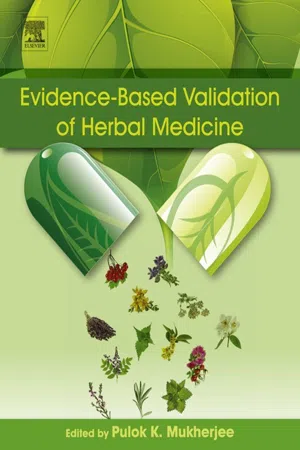
- 556 pages
- English
- ePUB (mobile friendly)
- Available on iOS & Android
Evidence-Based Validation of Herbal Medicine
About this book
Evidence-Based Validation of Herbal Medicines brings together current thinking and practice in the areas of characterization and validation of natural products. This book reviews all aspects of evaluation and development of medicines from plant sources, including their cultivation, collection, phytochemical and phyto-pharmacological evaluation, and therapeutic potential. Emphasis is placed on describing the full range of evidence-based analytical and bio-analytical techniques used to characterize natural products, including –omic technologies, phyto-chemical analysis, hyphenated techniques, and many more.- Includes state-of-the-art methods for detecting, isolating, and performing structure elucidation by degradation and spectroscopic techniques- Covers biosynthesis, synthesis, and biological activity related to natural products- Consolidates information to save time and money in research- Increases confidence levels in quality and validity of natural products
Frequently asked questions
- Essential is ideal for learners and professionals who enjoy exploring a wide range of subjects. Access the Essential Library with 800,000+ trusted titles and best-sellers across business, personal growth, and the humanities. Includes unlimited reading time and Standard Read Aloud voice.
- Complete: Perfect for advanced learners and researchers needing full, unrestricted access. Unlock 1.4M+ books across hundreds of subjects, including academic and specialized titles. The Complete Plan also includes advanced features like Premium Read Aloud and Research Assistant.
Please note we cannot support devices running on iOS 13 and Android 7 or earlier. Learn more about using the app.
Information
Quality Related Safety Issue-Evidence-Based Validation of Herbal Medicine Farm to Pharma
Abstract
Keywords
Herb–drug interaction; Marker profiling; Pharmacovigilance; Quality control; Safety evaluation; Standardization1.1. Health Care through Herbal Medicine
Table of contents
- Cover image
- Title page
- Table of Contents
- Copyright
- Contributors
- Foreword
- Preface
- Acknowledgments
- Chapter 1. Quality Related Safety Issue-Evidence-Based Validation of Herbal Medicine Farm to Pharma
- Chapter 2. Value Chains of Herbal Medicines—Ethnopharmacological and Analytical Challenges in a Globalizing World
- Chapter 3. Traditional Herbal Medicine, Pharmacognosy, and Pharmacopoeial Standards: A Discussion at the Crossroads
- Chapter 4. Taxonomy—An Irreplaceable Tool for Validation of Herbal Medicine
- Chapter 5. Validation of Medicinal Herbs for Skin Aging
- Chapter 6. Proangiogenic Potential of Medicinal Plants in Wound Healing
- Chapter 7. Pharmacovigilance: Tools in Establishing the Safety and Acceptability of the Natural Health Products—Clinical Evaluation
- Chapter 8. Validation of Antiviral Potential of Herbal Ethnomedicine
- Chapter 9. Harmonization of Regulatory Requirements in Europe to Ensure Quality, Safety and Efficacy of Herbal Medicinal Products
- Chapter 10. Bioavailability of Herbal Products: Approach Toward Improved Pharmacokinetics
- Chapter 11. Good Quality and Clinical Practices for the Future Development of Herbal Medicines
- Chapter 12. Traditional Medicine-Inspired Evidence-Based Approaches to Drug Discovery
- Chapter 13. Evaluation of Bioactive Compounds as Acetylcholinesterase Inhibitors from Medicinal Plants
- Chapter 14. Drugs and Drug Leads Based on Natural Products for Treatment and Prophylaxis of Malaria
- Chapter 15. Evaluation of Natural Products against Biofilm-Mediated Bacterial Resistance
- Chapter 16. Clinical Effects of Caraway, a Traditional Medicine for Weight Loss
- Chapter 17. Challenges in Identification of Potential Phytotherapies from Contemporary Biomedical Literature
- Chapter 18. Botanicals as Medicinal Food and Their Effects against Obesity
- Chapter 19. Applications of High Performance Liquid Chromatography in the Analysis of Herbal Products
- Chapter 20. Ayurveda – Opportunities for Developing Safe and Effective Treatment Choices for the Future
- Chapter 21. Discovery and Development of Lead Compounds from Natural Sources Using Computational Approaches
- Chapter 22. Infrared Spectroscopic Technologies for the Quality Control of Herbal Medicines
- Chapter 23. Antimicrobial Secondary Metabolites—Extraction, Isolation, Identification, and Bioassay
- Chapter 24. Uses of Herbals in Cardiac Diseases: Priority of Evidence Over Belief
- Index